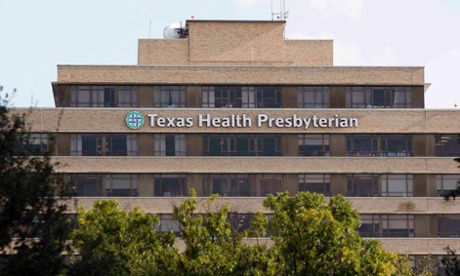The patient, who arrived in the US from Liberia on 20 September, is being treated in Dallas, Texas

The first patient to be diagnosed with Ebola outside of Africa is, as of Tuesday evening, seriously ill in a Dallas hospital. The patient, who arrived in the US from Liberia on 20 September, tested positive for Ebola on Tuesday.
Here is what we know about the case thus far – and what we don’t.
At this time, the patient’s citizenship and gender have not been released. However, doctors at a Tuesday evening briefing about the case repeatedly referred to the patient using male pronouns.
The patient’s full travel history is still unknown, except that he was in Liberia. As far as officials know, the patient was not responding to the outbreak in west Africa when he became infected. The circumstances in which he contracted the disease are not yet known.
The patient was checked for fever, a symptom of Ebola, before boarding a plane out of Liberia on 19 September. He had no symptoms when departing Liberia, meaning, according to experts, that he could not have transmitted it to other passengers on his flight or flights. Only patients who are sick with or have died from Ebola can transmit the disease, and Ebola can only be spread through direct contact with blood or bodily fluids. As Centers for Disease Control (CDC) director Thomas Frieden said at a briefing about the case on Tuesday, “The issue is not that Ebola is highly infectious. The issue with Ebola is that the stakes are so high.”
The patient arrived in the US on 20 September, and was staying with family who live in the US, possibly somewhere around Dallas-Fort Worth, as he was later admitted to a hospital in the area.
On 24 September the patient began developing symptoms of Ebola, which can include high fever, vomiting, diarrhoea and in serious cases internal and external bleeding. Symptoms can show themselves between two and 21 days after exposure to Ebola, but usually appear within eight to ten days.
On 26 September the patient sought treatment for the first time, but was not admitted to a hospital. The reasons why he was not admitted are not yet known.
On 28 September the patient was admitted to Texas Health Presbyterian Hospital in Dallas and placed in isolation. Texas Health Presbyterian Hospital is not one of the handful of institutions in the US that have special bio-containment units established to treat cases like this, but Frieden said at the Tuesday briefing that at this point there is “no need from either a medical or infection control standpoint to try to move the patient.”
On 30 September the CDC received specimens from the infected individual, tested them and determined that they were positive for Ebola. A state-operated laboratory in Texas also concluded that the specimens tested positive for Ebola. Frieden said Tuesday that the test for Ebola is “highly accurate”.
Frieden said the family and health officials are discussing “experimental therapies”, potentially including the ones successfully used on Ebola patients brought from Africa to the US, but whether this patient receives them will depend in part on availability.
Public health officials will now work to identify anyone who came into contact with the patient since he began showing symptoms. Once those people are identified they will be monitored for 21 days, the incubation period for the disease, to see if they develop a fever. If someone begins showing symptoms, that individual will be immediately isolated and treated.
